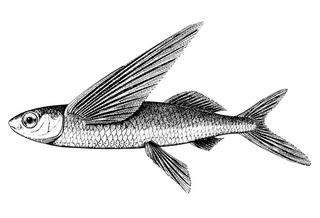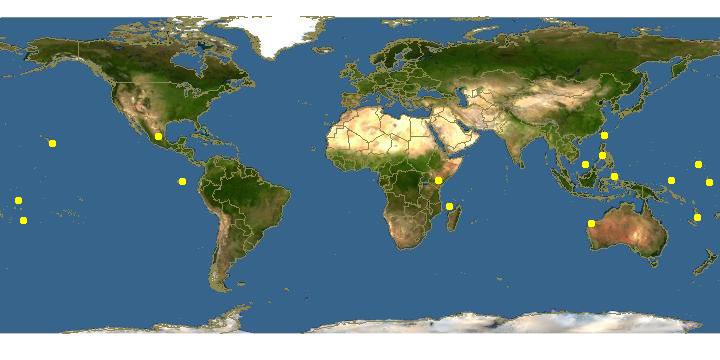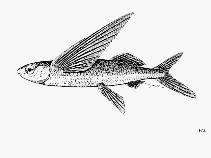
www.fao.org Copyright Michel Lamboeuf · 0
Cypselurus angusticeps |

Click on map for details about points.
|
| Links |
We parsed the following live from the Web into this page. Such content is managed by its original site and not cached on Discover Life. Please send feedback and corrections directly to the source. See original regarding copyrights and terms of use.
- Australian Faunal Directory
- FishBase
|
|
espa˝ol |
|
|
Overview |
Main identification features
- dorsal fin pale
- tail fin dusky
- pectoral: 2/3 grey, clear margin
- pelvic grey, dark base
- anal fin white
Head relatively narrow & pointed; snout equal to or slightly longer than eye; slightly concave between eyes; pectoral reaches past anal base, with 1st ray unbranched; lateral line without a branch to base of pectoral; pelvics origin nearer anal origin than pectoral base, reach beyond anal origin, anal origin under or behind 3rd dorsal ray; lower jaw a little shorter than and enclosed by upper jaw, upper jaw not protrusible; at least some jaw teeth with 3 points; 24-30 scales before dorsal fin; dorsal 12-14 rays; anal 8-9 rays; juveniles with 1 broadly flattened chin barbel.
Dark above, paler below; dorsal fin pale grey; pectorals upper 2/3 red-grey, rest clear; anal white; tail dusky; pelvics pale, dusky in center of base.
Size: 24 cm.
Habitat: pelagic, coastal and offshore islands.
Depth: surface 0-20 m?.
Central and eastern Pacific; the Revillagigedos Islands and in the SE Gulf of California.
Attributes
Abundance: Common.
Cites: Not listed.
Climate Zone: Northern Tropical (Mexican Province to Nicaragua + Revillagigedos); Northern Subtropical (Cortez Province + Sinaloan Gap).
Depth Range Max: 20 m.
Depth Range Min: 0 m.
Diet: zooplankton; pelagic fish larvae; pelagic fish eggs.
Eastern Pacific Range: Northern limit=24; Southern limit=19; Western limit=-115; Eastern limit=-107; Latitudinal range=5; Longitudinal range=8.
Egg Type: Pelagic; Pelagic larva.
Feeding Group: Planktivore.
FishBase Habitat: Pelagic.
Global Endemism: All Pacific (West + Central + East); TEP non-endemic; Pacific only (East + Central &/or West); "Transpacific" (East + Central &/or West Pacific); All species.
Habitat: Water column.
Inshore Offshore: Offshore; Offshore Only.
IUCN Red List: Not evaluated / Listed.
Length Max: 24 cm.
Regional Endemism: Continent; Island (s); Tropical Eastern Pacific (TEP) non-endemic; Eastern Pacific non-endemic; Continent + Island (s); All species.
Residency: Resident.
Salinity: Marine; Marine Only.
Water Column Position: Surface; Water column only;
|
|
|
Names | |
|
|
|
Links to other sites | |
|
|
|
References |
- BÚarez, P., 1996., Lista de los Peces Marinos del Ecuador Continental., Revista de Biologia Tropical, 44:731-741.
- Castro-Aguirre, J.L. and Balart, E.F., 2002., La ictiofauna de las islas Revillagigedos y sus relaciones zoogeograficas, con comentarios acerca de su origen y evolucion. En: Lozano-Vilano, M. L. (Ed.). Libro Jubilar en Honor al Dr. Salvador Contreras Balderas., Universidad Autonoma de Nuevo Leˇn:153-170.
- Findley, L.T., Hendrickx, M.E., Brusca, R.C., van der Heiden, A.M., Hastings, P.A., Torre, J., 2003., Diversidad de la Macrofauna Marina del Golfo de California, Mexico., CD-ROM versiˇn 1.0. Projecto de la Macrofauna del Golfo .á Derechos reservados de los autores y Conservaciˇn Internacional.
- Fischer , W. , Krup , F. , Schneider , W. , Sommer , C. , Carpenter , K. E. and Niem, V. H., 1995., Guia FAO para la Identificacion de Especies de para los fines de la Pesca. Pacifico Centro-Oriental. Volumen II. Vertebrados - Parte 1., FAO2:647-1200.
- Jimenez-Prado, P., BÚarez, P., 2004., Peces marinos del Ecuador continental / Marine fishes of continental Ecuador., SIMBIOE/NAZCA/IFEA tomo 1 y 2.
- Nichols , J. T. and Breder, C. M., 1935., New pacific flying-fishes collected by templeton crocker., Amer. Mus. Novit., (821):1-4.
|
|
|
Acknowledgements | |
I thank Ashley MacDonald and John Pickering, University of Georgia, for technical support in building this page.
|
|
| Supported by | |
|
Following modified from Australian Faunal Directory
|
Top | See original
| &pull 20q v5.145 20180528: Error 301 Moved Permanently http://biodiversity.org.au/afd/taxa/36445673-2e70-451b-97fd-abaae410e60f/ |
|
Following modified from FishBase
|
Top | See original
http://www.fishbase.org/Summary/speciesSummary.php?genusname=Cypselurus&speciesname=angusticeps ---> http://52.67.158.155/Summary/speciesSummary.php?genusname=Cypselurus&speciesname=angusticeps
http://52.67.158.155/Summary/speciesSummary.php?genusname=Cypselurus&speciesname=angusticeps ---> https://fishbase.net.br/Summary/speciesSummary.php?genusname=Cypselurus&speciesname=angusticeps
https://fishbase.net.br/Summary/speciesSummary.php?genusname=Cypselurus&speciesname=angusticeps ---> https://fishbase.net.br/summary/Cypselurus-angusticeps.html
Cypselurus angusticeps, Narrowhead flyingfish : fisheries

You can
sponsor
this page
Common name (e.g. trout)
Genus + Species (e.g. Gadus morhua)
-

-
About this page
-
Languages
-
User feedbacks
-
Citation
-
Uploads
-
Related species
-


 Narrowhead flyingfish
Add your observation in
Fish Watcher
Upload your
photos
and
videos
Narrowhead flyingfish
Add your observation in
Fish Watcher
Upload your
photos
and
videos
Pictures
|
Google image
 Cypselurus angusticeps
Cypselurus angusticeps
Picture by
FAO
Teleostei (teleosts) >
Beloniformes
(Needle fishes) >
Exocoetidae
(Flyingfishes)
Etymology:
Cypselurus:
Greek, kypselos, ou = swift + Greek,oura = tail (Ref.
45335
)
.
More on authors:
Nichols
&
Breder
.
Environment: milieu / climate zone / depth range / distribution range
Ecology
Marine; pelagic-oceanic; oceanodromous (Ref.
51243
); depth range 0 - 20 m (Ref.
27313
). Tropical; 34°N - 23°S, 43°E - 79°W
Indo-Pacific: East Africa to Hawaii and the Tuamoto Islands. Probably absent from the inland seas of southeast Asia. Eastern Pacific: isolated population at Soccoro Islands, Mexico, including Revillagigedo Islands.
Size / Weight / Age
Maturity: L
m
?
range ? - ? cm
Max length : 24.0 cm SL male/unsexed; (Ref.
9839
)
Dorsal
soft rays
(total): 13;
Anal
soft rays
: 8 - 9. Pectoral fins almost uniformly grayish, varying in tone but neither hyaline nor blackish, with a narrow pale posterior edge broadening at the tip and toward the axil of the fin. Predorsal scales 28-30. Ventral origin equidistant from about or behind the middle of opercle and base of caudal. Head narrow and pointed for this genus, the snout equal to or slightly longer than eye. Teeth tricuspid. Interobital slightly concave; eye slightly infralateral. Coloration: Dark above to below midline of side, pale below; dorsal very pale grayish; anal white; caudal uniform dusky; ventrals pale becoming slightly dusky in the center of their base.
Epipelagic in coastal and oceanic waters. Often near oceanic islands. May leap out of the water and glide over considerable distances above the surface. Also caught using dipnet and light method (Ref.
9839
).
Life cycle and mating behavior
Maturity
|
Reproduction
|
Spawning
|
Eggs
|
Fecundity
|
Larvae
Nichols, J.T. and C.M. Breder Jr.
, 1935. New Pacific flying-fishes collected by Templeton Crocker. Am. Mus. Novit. 821:1-4. (Ref.
98576
)
IUCN Red List Status (Ref.
130435
)
Not Evaluated
CITES
Not Evaluated
Not Evaluated
Threat to humans
Harmless
Human uses
Fisheries: minor commercial
FAO - Publication:
search
|
FishSource
|
More information
Countries
FAO areas
Ecosystems
Occurrences
Introductions
Stocks
Ecology
Diet
Food items
Food consumption
Ration
Common names
Synonyms
Metabolism
Predators
Ecotoxicology
Reproduction
Maturity
Spawning
Spawning aggregation
Fecundity
Eggs
Egg development
Age/Size
Growth
Length-weight
Length-length
Length-frequencies
Morphometrics
Morphology
Larvae
Larval dynamics
Recruitment
Abundance
BRUVS
References
Aquaculture
Aquaculture profile
Strains
Genetics
Electrophoreses
Heritability
Diseases
Processing
Nutrients
Mass conversion
Collaborators
Pictures
Stamps, Coins Misc.
Sounds
Ciguatera
Speed
Swim. type
Gill area
Otoliths
Brains
Vision
Tools
E-book
|
Field guide
|
Identification keys
|
Length-frequency wizard
|
Life-history tool
|
Point map
|
Classification Tree
|
Catch-MSY
|
Special reports
Check for Aquarium maintenance
|
Check for Species Fact Sheets
|
Check for Aquaculture Fact Sheets
Download XML
Summary page
|
Point data
|
Common names
|
Photos
Internet sources
AFORO (otoliths)
|
Aquatic Commons
|
BHL
|
Cloffa
|
BOLDSystems
|
Websites from users
|
Check FishWatcher
|
CISTI
|
Catalog of Fishes
:
genus
,
species
|
DiscoverLife
|
ECOTOX
| FAO - Publication:
search
|
Faunafri
| Fishipedia |
Fishtrace
| GenBank:
genome
,
nucleotide
| GloBI |
Google Books
|
Google Scholar
|
Google
| IGFA World Record |
MitoFish
|
National databases
|
Otolith Atlas of Taiwan Fishes
|
PubMed
| Reef Life Survey | Socotra Atlas |
Tree of Life
| Wikipedia:
Go
,
Search
| World Records Freshwater Fishing |
Zoobank
|
Zoological Record
Estimates based on models
Preferred temperature (Ref.
123201
): 24.4 - 29.3, mean 27.7 °C (based on 32228 cells).
Phylogenetic diversity index (Ref.
82804
): PD
50
= 0.5002 [Uniqueness, from 0.5 = low to 2.0 = high].
Bayesian length-weight: a=0.00646 (0.00292 - 0.01429), b=3.04 (2.84 - 3.24), in cm total length, based on LWR estimates for this (Sub)family-body shape (Ref.
93245
).
Trophic level (Ref.
69278
): 4.0 ±0.6 se; based on size and trophs of closest relatives
Resilience (Ref.
120179
): High, minimum population doubling time less than 15 months (Preliminary K or Fecundity.).
Fishing Vulnerability (Ref.
59153
): Low vulnerability (19 of 100).
Price category (Ref.
80766
):
Medium
.
Back to Search
Random Species
Back to Top
Accessed through:
Not available
FishBase mirror site :
Laguna, Philippines
Page last modified by :
mrius-barile
|
Updated: 2024-05-07 05:13:40 gmt
|